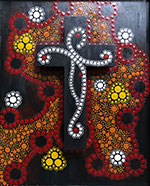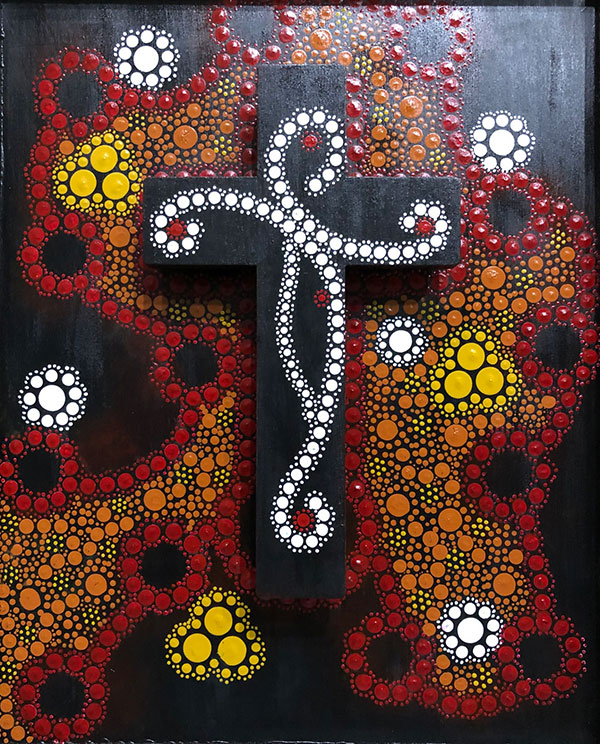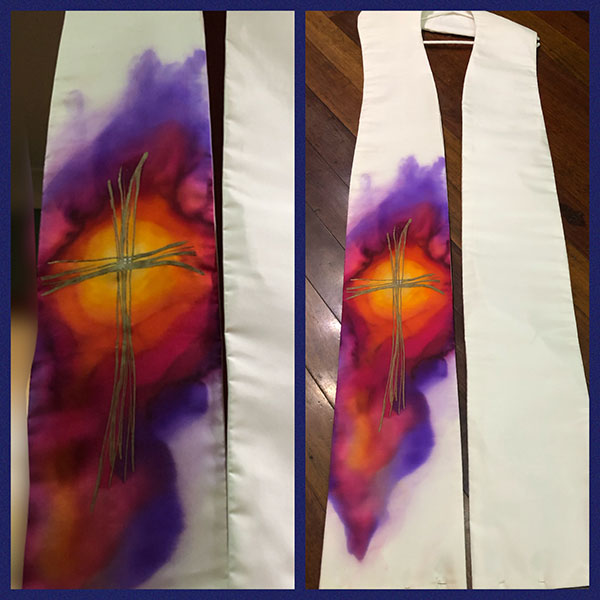 Introduction
Introduction
I met Helen Bachmann at the Mystery and Mission conference, in Brisbane, 28-30 September, 2023, celebrating sixty years since Vatican II’s Constitution on the Sacred Liturgy, presented jointly by the Australian Pastoral Musicians Network & the National Liturgical Council of the Australian Catholic Bishops’ Conference.
It was Helen’s artwork which invited the attendees to prayer, reflection and contemplation in liturgical settings and via digital platforms. It is with pleasure that I introduce Helen’s work to a wider audience through the website of the National Liturgical Art and Architecture Council (NLAAC) which show cases the best of Australian Catholic liturgical art.
In his book Art + Faith, a Theology of Making, Makoto Fujimura (YUP, 2020) introduces us to caring and loving in the work of making. He invites us to consider artists as makers who navigate “the gap between ideas and reality” (p.63). He goes so far as to say that “love demands creativity” and that “the beauty of art invokes the God of Creation, the Spirit of mediation into the heart of love” (p.64). Critically Fujimura makes it abundantly clear that “churches are not investing enough time and effort in thinking about the context of communication, and they are not empowering makers” (p.68). As an artist himself, he considers that “art is fundamental to the human search for deeper understanding” and indeed that this “deeper knowledge of the imagination is the basis of all knowledge”. Fujimura argues that “the resurrected Christ waits until we create, until the soil we cultivate is harvested, and until we make, to reveal himself to us!” (p.73).
Artist’s statement:
Helen Bachmann is a Mununjali woman of the Yugambeh Nation, the area that is now known as the Beaudesert area of Southern Queensland. Helen was raised in a Catholic household and has strong connection and dedication to her Catholic faith while also acknowledging and valuing her Aboriginal spirituality. This deep spirituality is firmly situated in all aspects of her life, it comes through especially in her faith and her art. Her Christianity is forever in dialogue with her Aboriginal spirituality. Sometimes the interaction is seamless, other times it causes an experience of interruption.
As an artist, Helen works in a variety of mediums. Currently, much of her work is created digitally, however, she also works in silk painting and acrylic on board. Most of her work expresses her Aboriginal spirituality in dialogue with her Catholic faith.
Four examples of Helen Bachmann’s work in various media (acrylic on board, silk and steam set dye and digital) are presented to you for consideration and contemplation.
Title: Stations of the Cross.
Medium: Acrylic on Board (mixed media). This piece has had a wooden cross added centrally in relief. The cross stands out from the base of the work by approximately 10mm. Acrylic paint has been used for the entire piece.
Size: 400 X 300mm.
Description: In this piece, each station is marked by a circle. While it can be just a symbol to mark a stop along the path, the circle is strong in meaning in many First Nations cultures. In Australian Aboriginal culture circles generally represent a place where people come together, a meeting place, a waterhole, a place for ceremony, a communal fire or a campsite. From a Christian lens, the circle, with no beginning and no end, represents the presence of our eternal God. At each station there is a meeting of people, and our Triune God is always present.
The twelfth station is represented through the central figure of Jesus on the cross. The five stars of the Southern Cross mark the wounds Jesus suffered, the blood he shed. The circle is still present, sitting at the foot of the cross.
Date: 2022.
Location: Private collection.

Title: Holy Mary.
Medium: Silk and steam set dye.
Size: 1200 X 6000mm.
Description: This liturgical silk was painted as a gift for a priest departing our parish, he is from the Order of Carmelites of Mary Immaculate (CMI). There is not a lot of story in this piece, apart from the fact that the recipient of the gift has a special place in his heart for Mary and he will use it throughout his life of service.
Liturgical silks are not made to hang in a gallery. They generally are used to beautify a liturgical environment or to allow people to connect with the Gospel message in a different way to what they may be used to. While painting silk with dyes is generally an exercise in letting the dye do what it wants, there are ways to semi-control the dye movement, as is the case in some of this piece.
Date: 2023.
Location: Private collection.

Priest stoles
Title: Trinity.
Medium: Silk and steam set dye. Cotton backing.
Size: Approx 1400 X 200mm.
Description: The art on this stole represents Trinity. God the Father is symbolised by the circle. The circle keeps growing out from the centre of the image; God’s love continues growing eternally. God the Son is represented by the cross and God the Spirit is represented through the colours of a flame.
Date: 2020.
Location: Private collection.

Title: Transfiguration.
Medium: Digital Image (iPad).
Size: Can be printed in a variety of sizes or projected onto church screens.
Description: Initially this image was created in response to the Biblical text of the Transfiguration (MATT 17:1-5). However, for me it also speaks of Trinity. This image also speaks to the question ‘What is God to me?’ Therefore, an alternative title is ‘God is.’
Date: 2023.
Location: Digital collection of Liturgy Brisbane.

Dr Ursula de Jong, member, NLAAC, 2024.
